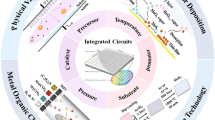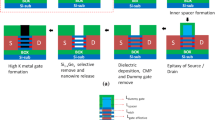Abstract
We propose a two-step hydrogen-ion implantation approach for realizing crystalline-defect-free Si1-xGex channels for potential use in gate-all-around field-effect-transistors beyond the 3 nm transistor-design rule. A dislocation sink was created in a projected range of ion implantation 100 and 200 nm above the strain-relaxed Si0.7Ge0.3 layer and Si substrate interface using two-step H+ -ion implantation. Doses of 5 × 1015 and 2 × 1015 atoms/cm2 were used at 100 and 200 nm, respectively, above the interface, and post-annealing was performed at 800 °C for 30 min. The two-step implantation annihilated the misfit and threading dislocations near the relaxed Si0.7Ge0.3/Si interface. The annihilation efficiency strongly depended on the location and second ion dose of the implantation: the maximum annihilation efficiency was obtained at 100 and 200 nm above the interface with multiple H+-ion doses of 5 × and 2 × 1015 atoms/cm2.





Similar content being viewed by others
References
M.T. Bohr, I.A. Young, CMOS scaling trends and beyond. IEEE Comput. Soc. 17, 0272–1732 (2017)
E. Sicard, L. Trojman, Introducing 5-nm FinFET technology in Microwind. Archive ouverte HAL, hal-03254444 (2021)
Y. Ding et al., A device design for 5 nm logic FinFET technology. J. Microelectron. Manuf. 3, 20030105 (2020)
W.C. Jeong et al., True 7nm platform technology featuring smallest FinFET and smallest SRAM cell by EUV, special constructs and 3rd generation single diffusion break. VLSI technology digest of technical papers, pp. 59–60 (2018)
H.-J. Cho et al., Si FinFET based 10nm Technology with multi Vt gate stack for low power and high performance applications. VLSI Technology Digest of Technical Papers, pp. 1–2 (2016)
D. Ha et al., Highly manufacturable 7nm FinFET technology featuring EUV lithography for low power and high performance applications. VLSI Technology Digest of Technical Papers, pp. T68 (2017)
N. Loubet et al., Stacked nanosheet gate-all-around transistor to enable scaling beyond FinFET. VLSI Technology Digest of Technical Papers, pp. T230–T231 (2017)
G.J. Bae et al., 3nm GAA technology featuring multi-bridge-channel FET for low power and high performance applications. IEEE International Electron Devices Meeting (IEDM), pp. 28.7.1–28.7.4 (2018)
T.Z. Hong et al., First demonstration of heterogenous complementary FETs utilizing low-temperature (200°C) hetero-layers bonding technique (LT-HBT). IEEE International Electron Devices Meeting (IEDM), pp. 15–5 (2020)
W. Lian et al., Ultra high hole mobility in Ge films grown directly on Si (100) through interface modulation. J. Cryst. Growth 548, 125838 (2020)
T.H. Shim et al., Hole mobility behavior in strained SiGe-on-SOI p-MOSFETs. ECS Trans. 13, 345 (2008)
G. Höck et al., High hole mobility in Si0.17Ge0.83 channel metal–oxide–semiconductor field-effect transistors grown by plasma-enhanced chemical vapor deposition. Appl. Phys. Lett. 76, 3920 (2000)
Z. Lixing et al., Hole mobility degradation by remote Coulomb scattering and charge distribution in Al2O3/GeOx gate stacks in bulk Ge pMOSFET with GeOx grown by ozone oxidation. J. Phys. D Appl. Phys. 50, 245102 (2017)
F. Schäffler et al. in Properties of Advanced Semiconductor Materials (Wiley, New York, 2001)
M.T. Currie et al., Carrier mobilities and process stability of strained Si n- and p-MOSFETs on SiGe virtual substrates. J. Vac. Sci. Technol. B 19, 2268 (2001)
J.W. Ma et al., Carrier mobility enhancement of tensile strained Si and SiGe nanowires via surface defect engineering. Nano Lett. 15, 7204–7210 (2015)
X. Ma et al., Strain stability and carrier mobility enhancement in strained Si on relaxed SiGe-on-insulator. J. Electrochem. Soc. 157, H104 (2010)
J.G. Park et al., Strained Si engineering for nanoscale MOSFETs. Mater. Sci. Eng. B Solid State Mater. 134, 142 (2006)
T.H. Shim, S.J. Kim, J.G. Park, Dependence of electrical characteristics on Si thickness and Ge concentration for unstrained Si grown on strained SiGe-on-insulator n-metal–oxide–semiconductor field-effect transistor. Jpn. J. Appl. Phys. 46, 3324 (2007)
T.H. Kim, J.G. Park, Effective multi-step Ge condensation process using intermittent SiO2 strip to obtain a high-Ge concentration and a thick Ge-on-insulator (GeOI) substrate for p-MOSFET. J. Korean Phys. Soc. 62, 531 (2013)
S.J. Choi et al., Dislocation sink annihilating threading dislocations in strain-relaxed Si1−xGex layer. Nanotechnology 31, 12LT01 (2020)
S.M. Sze, K.K. Ng, Physics of Semiconductor Devices (John Wiley & Sons, New York, 2006)
D.C. Houghton, Strain relaxation kinetics in Si1−xGex/Si heterostructures, J. Appl. Phys. 70 (4) (1991) 2136
P.M. Mooney et al., Nucleation of dislocations in SiGe layrers grown on (001)Si. J. Appl. Phys. 75 (8), (1994)
F.K. LeGoues, B.S. Meyerson, J.F. Morar, Anomalous strain relaxation in SiGe thin films and superlattices. Phys. Rev. Lett. 66, 22 (1991)
G. Wang et al., A model of threading dislocation density in strain-relaxed Ge and GaAs epitaxial films on Si (100). Appl. Phys. Lett. 94, 102115 (2009)
Acknowledgements
This work was supported by the National Research Foundation of Korea (NRF) grant funded by the Korea government (MSIT) (No. 2021R1A4A10520850), BrainKorea21 Four.
Author information
Authors and Affiliations
Corresponding author
Additional information
Publisher's Note
Springer Nature remains neutral with regard to jurisdictional claims in published maps and institutional affiliations.
Rights and permissions
About this article
Cite this article
Park, JH., Park, JG. Two-step hydrogen-ion implantation annihilation of threading dislocation defects in strain-relaxed Si0.7Ge0.3. J. Korean Phys. Soc. 79, 1151–1156 (2021). https://doi.org/10.1007/s40042-021-00340-7
Received:
Revised:
Accepted:
Published:
Issue Date:
DOI: https://doi.org/10.1007/s40042-021-00340-7




